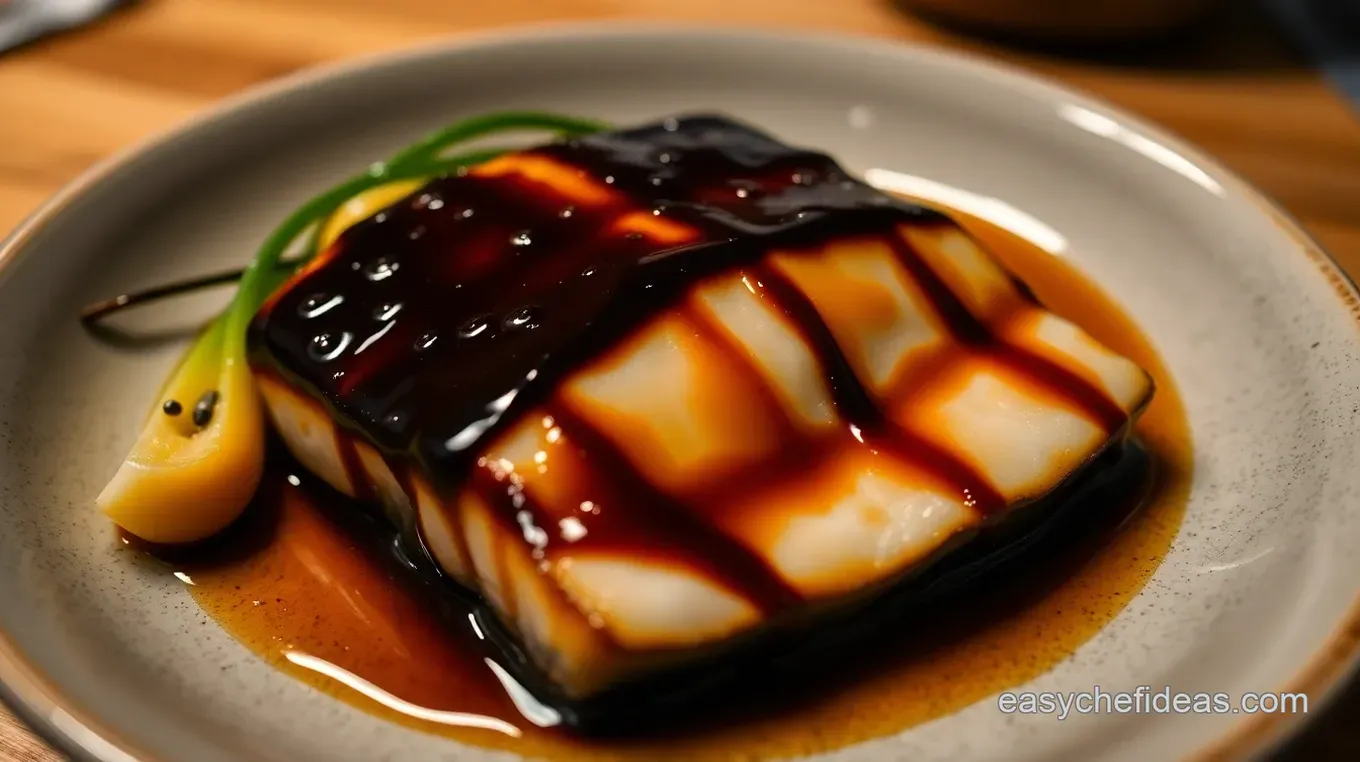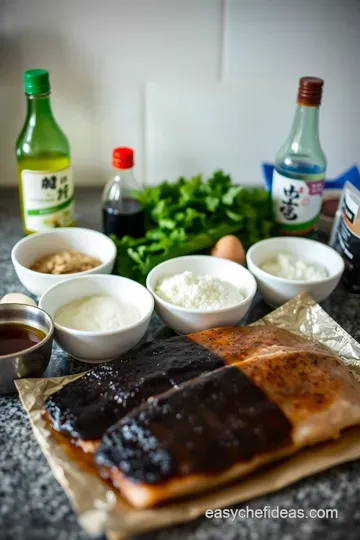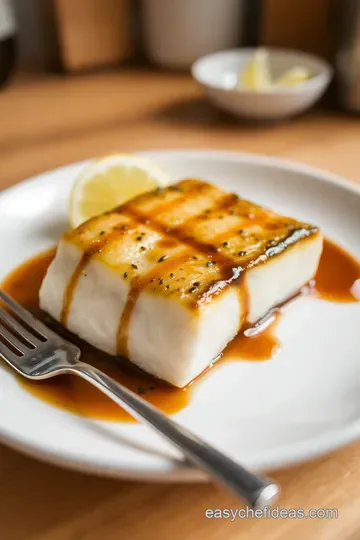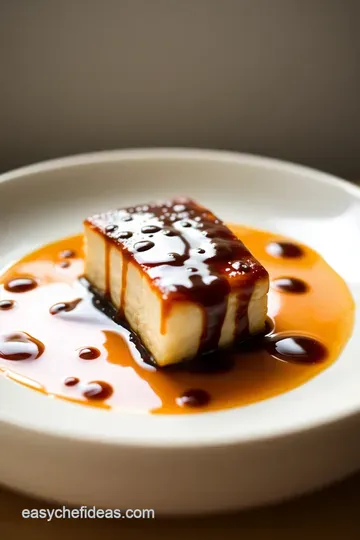Nobu-Style Black Cod with Miso Glaze (Miso-Marinated Black Cod)
Craving the best nobu black cod recipe? Try my simple miso black cod recipe! Juicy, flavorful, and foolproof—perfect for weeknights or special occasions. Discover my tips inside!

Ever wonder what it feels like to eat something so melt-in-your-mouth good, you think about it long after? that’s pretty much how i felt the first time i tried a nobu black cod recipe —a dish that’s basically a touch of japan’s finest right in your kitchen.
But honestly? it’s not as complicated as you might think. when i first dove into making it, i was convinced it’d be a disaster.
Nope. turned out to be one of those showstopper dishes that makes you feel fancy—without the fuss.
This dish, often called miso black cod or marinated cod , is rooted in japanese tradition. it’s inspired by nobu matsuhisa, a chef famous for blending japanese cuisine with a modern twist.
The secret? a sweet, savory miso glaze that’s been their signature. over the years, this tasty fish has gained major popularity outside the sushi bars, making its way onto fancy dinner tables and weeknight dinners alike.
Now, if you’re wondering how long it takes, here’s the scoop: the nobu black cod recipe needs some planning. you prep the marinade in about 20 minutes, then marinate the fish in the fridge for at least 2 hours—though i prefer overnight if i want the flavor to really soak in.
Cooking-wise? it’s a quick broil at around 8 to 10 minutes. not too bad, right? it’s not a walk in the park for total beginners, but with a little patience, you’ll be marveling at your own culinary skills.
The best part? it’s surprisingly affordable and yields about 4 servings, perfect for a date night or a small family dinner.
The ingredients are pretty straightforward, and most of us keep miso, sake, and mirin in the pantry already. so, it’s a great dish to impress without burning a hole in your wallet.
Besides being utterly delicious, there are some solid health perks too. black cod—or sablefish —is packed with omega-3 fatty acids, good for your heart and skin.
The miso adds probiotics, which are great for digestion. plus, the dish is a fantastic way to indulge without guilt, especially if you’re watching your carbs or fats.
And let me tell you, serving this makes any mealtime feel special. it’s perfect for celebratory dinners, anniversaries, or even just when you want to treat yourself.
Its silky texture, caramelized surface, and rich flavor really set it apart from typical fish recipes. honestly, comparing it to your average baked cod or fish tacos is like night and day.
This dish oozes luxury .
I love how it pairs with simple sides—white rice, steamed greens, maybe some pickled veggies. the flavors are bold enough to stand out but gentle enough to let the fish shine.
And, did i mention? you can tweak the marinade with a splash of yuzu or even toss in some grated ginger if you’re feeling adventurous.
If you want to try this nobu black cod recipe at home, i promise it’s worth the little extra effort.
Once you get the hang of broiling and marinating, you’ll be pulling this out for all kinds of occasions. it’s honestly become one of my go-to dishes when i want to wow guests or just feel like cooking something fancy but simple.
Next up, i’ll walk you through all the ingredients you’ll need, including the secret to perfect caramelization. trust me, once you try this, you’ll be hooked.
Ready to get started? let’s gather everything you’ll need to create restaurant-quality asian fish right in your own kitchen!

Hey there, fellow foodie! if you're obsessed with awesome asian fish recipes or just love that buttery, melt-in-your-mouth texture, then you're gonna want to stick around.
Today, i’m diving into the essential ingredients that make a nobu black cod recipe something special. it’s kind of like the secret sauce of japanese-inspired dishes, especially when you’re talking about a miso black cod recipe or the famous miso cod recipe that everyone raves about.
Trust me, once you get these core ingredients down, making that marinated cod or asian fish is way easier than you think.
First up, let’s chat about the premium core components . think of these as the backbone for any good dish. for black cod , quality really matters.
You want fresh fillets , ideally skin-on, though skin-off works too if that’s what you prefer. i found that buying fresh black cod from a trusted fishmonger or a good grocery store makes a huge difference.
The fish should look moist, firm, and smell like clean ocean water — no overpowering fishy smell! you want to use about 6-ounces per fillet, but always measure to keep proportions right.
When storing, keep it cold in the fridge and try to cook it within a day or two for the best freshness.
Now, the signature seasoning blend —this is where the magic happens. for the nobu black cod recipe , the star is the miso marinade .
The key ingredients are white miso paste (shiro miso) , mirin , sake , sugar, and a splash of soy sauce.
These combine to create that sweet-savory glaze that’s almost caramelized when broiled. i always say, use high-quality miso —it’s really the flavor base of the whole dish.
Herbs like scallions or a sprinkle of sesame seeds turn it into a totally gourmet experience. and if you want regional flair? sometimes i swap mirin with a little yuzu juice or add grated ginger — just a tiny kick to brighten things up.
Okay, onto smart substitutions —because let’s be honest, not everyone keeps the same stuff in their pantry. fancy japanese ingredients can be tricky sometimes.
No worries, you can swap out ingredients without losing that delicious vibe. out of miso? try mixing tahini with a bit of honey and soy sauce—sounds weird but works great! or, if you need an alcohol-free tweak, just replace the sake with some chicken broth or more mirin.
Seasonal options are also fun—throw in a splash of citrus like yuzu or lemon if you’re feeling extra fresh.
Now, the kitchen equipment essentials —keep it simple. a good oven with a broiler, a baking sheet, and some parchment paper are basically all you need.
I like to use cooking tongs to flip or remove the fish easily. if you want to get fancy, a meat thermometer helps to avoid overcooking.
My biggest tip? keep a close eye during broiling. that caramelization happens quick, and burnt miso is sad.
Finally, a quick note on storage: marinate the fish in a sealed bag or dish in the fridge overnight — honestly, that long marinate is what makes the nobu black cod so addictive.
When it’s time to cook, make sure to wipe off excess marinade for a better crust. easy!
Phew, enough tech talk — i think you’re getting the vibe. once you've got these ingredients, the pathway to a miso black cod recipe or black cod that screams restaurant-quality is pretty straightforward.
Honestly, this dish was a game-changer for me when i first tried it. it’s show-stopping yet surprisingly simple. it’s one of those recipes by ingredients that makes you feel like a professional chef, even if you’re just chillin’ in your kitchen.
So, get your ingredients ready, and i promise, the next steps will be a breeze. ready to jump into cooking? next up, i’ll walk you through the steps to make that amazing nobu black cod recipe that everyone keeps raving about.
Stay tuned!

Hey there! so, you wanna nail that nobu black cod recipe at home? honestly, i get it. this dish is like that secret superstar in asian fish recipes—silky, sweet, savory, and just crazy good.
I’ve tried a lot of miso black cod recipes over the years, but nothing beats going full pro with the prep and technique.
Let me walk you through some essential steps, honest tips, and what i learned along the way, so you get perfect results every time.
First off, let’s talk about preparation , because it really makes or breaks the dish. mise en place? yeah, it sounds fancy, but it’s just about all your ingredients ready to go.
Whisk together that miso, mirin, sake, sugar, soy sauce if you like (adds a nice depth), and a splash of rice vinegar if you’re feeling extra balanced.
Do this first—that way, your marinade is smooth and ready to coat the marinated cod evenly.
Now, the key here is marinating time. i used to think overnight wasn't necessary—think again! i learned that at least 2 hours , but really, giving it up to 24 hours in the fridge deepens that flavor.
The longer, the better—kind of like how a good marinade in asian fish dishes can really seep in flavor. just don’t go past 48 hours unless you want overly salty or mushy fish.
Pat the fillets dry before coating, so the marinade sticks and the surface caramelizes beautifully.
Here’s a little pro tip i picked up: organization is your best friend. lay out parchment paper, your fillets, and a lined baking sheet before you start.
That way, there's no scrambling when it's time to cook. oh, and safety first—use oven mitts when handling hot sheets, and keep an eye on it.
Broilers can be unpredictable, and nothing’s sadder than burning that gorgeous miso crust.
Step-by-step? it’s pretty straightforward. first, preheat the broiler—about 6 inches from the heat source —and line your pan with foil or parchment (trust me, cleanup’s a breeze).
Remove the excess marinade gently—that’s crucial because too much moisture will prevent that caramelized outcome. place your fillets skin-side down if they have skin—the skin adds flavor and helps hold everything together.
Then, broil for about 4- 5 minutes .
Now, don’t go totally hands-off here. watch those fillets! the surface should turn golden brown and look slightly blistered—like a beautiful glaze.
Use a meat thermometer , aiming for an internal temp of 140° f . the fish should be opaque and flaky—no need to overcook.
I’ve made the mistake of pulling it too early or too late, but temp control is a game changer.
Once it’s out, give it a minute to rest, then garnish with toasted sesame seeds and chopped scallions. honestly, simple, but it adds so much flavor and those nice textures.
Serve with steamed rice, and maybe some sautéed greens—my all-time combo: richness with freshness.
Now, about expert techniques —these aren’t必须, but they help elevate your dish. think about brushing on a little more marinade in the last minute for extra flavor or even broiling on high for an extra caramelized crust.
Or, if you find your fish isn’t flaky enough, double-check your internal temp. sometimes, the visual cue of the opaque color and flaky texture is the best guide.
And here’s something i struggled with initially: troubleshooting . if your fish looks burnt but isn’t cooked through, it’s probably the broiler too close or too high.
Dial it back, or move the rack a little lower. if the glaze is too thick or burnt, brush off some and give it a quick blast again.
Trust me, it’s all about timing and watching closely.
Lastly, success strategies —don’t forget, avoiding common mistakes is half the battle. over-marinating can make fish mushy. overcooking makes it dry.
Also, quality matters—use fresh, thick-cut black cod or whatever premium fish you can get. the difference is night and day.
Don’t forget, you can totally prep this ahead . Marinate overnight, keep it covered in the fridge, then broil just before dinner. Works like a charm for busy weeknights or impressing guests.
Alright, that’s the scoop! next up, i’ll dive into some additional info —maybe some variations or serving tips, but for now, get your mise en place ready and your fish marinating.
You’ll be surprised how close you get to that fancy nobu vibe right in your own kitchen.

Absolutely! let’s dive into some pro tips and secrets that’ll make your nobu black cod recipe turn out even more amazing.
I’ve cooked this dish a few times, and honestly, it’s kinda like my secret weapon for impressing guests without breaking a sweat.
First off, timing is everything with marinated cod. the longer you marinate, the deeper that umami gets—think of it like a flavor soak.
I’ve left my black cod in for 24 hours, and wow, the fish just soaks up all that sweet, savory goodness.
But don’t worry if you’re rushed —even 2- 3 hours does the trick. oh, and if you’re like me and sometimes forget about marinating (it’s real life, folks), just plan ahead! you can marinate this up to 2 days in advance, which honestly saves so much time on the day of cooking.
Now, a little tip i swear by — when you're ready to broil, make sure your oven rack is about 6 inches from the heat.
That way, you get that gorgeously caramelized top without burning the edges. keep a close eye! the first time i over-browned my marinade, and let’s just say i learned my lesson—watching it turn to char was not pretty.
Timing-wise, 4 to 5 minutes is usually perfect, but every oven is different. use a quick read of 140° f in the thickest part of the fish if you have a thermometer—that’s the sweet spot for perfectly flaky, juicy black cod .
Okay, flavor boost? use high-quality white miso — don’t go cheap here. it’s what gives this dish that signature silky, melt-in-your-mouth texture.
I once tried a darker miso, and it just didn’t have that delicate sweetness. also, a tiny trick: a dash of rice vinegar in your marinade can balance out the richness, but don't go overboard.
You want a subtle hint, not a salad dressing.
Presentation-wise, just think simple and elegant. you know those instagram shots with a sprinkle of sesame seeds and scallions? yeah, try that.
I like to slice the fish slightly at an angle, letting those caramelized edges shine, then topping with a bit of toasted sesame and chopped green onions.
If you’re feeling fancy, squeeze some lemon over the top—that little citrus tang does wonders.
On the storage front, here's the scoop: leftover miso black cod can be refrigerated in an airtight container for up to 2 days .
Reheat it gently — i usually microwave at about 50% power, just to keep it from drying out. honestly, it's like a new dish when warmed up, and the flavors still pop.
Thinking of making this ahead for a dinner party? marinate your fillets overnight, then broil right before guests arrive. for best results, avoid freezing marinated fish — it can mess with the texture.
Instead, keep it fresh for that perfect melt-in-your-mouth bite.
Looking to get creative? swap ingredients to keep things interesting. during the holidays, i love adding a splash of yuzu juice or grated ginger to the marinade for a seasonal twist.
Want a lower sodium option? just cut back a tiny bit on soy sauce or use a saltier miso, which adds flavor without added salt.
Regional tweaks? try a dash of sriracha or miso mixed with honey for a sweet heat angle.
Lastly, this dish's nutrition profile is pretty kick-ass — packed with omega-3s and protein. It’s definitely a guilt-free indulgence that’s healthy, too.
So, there you go! the key is patience with the marinade and attention during broiling. once you nail those, i promise you’ll feel like a professional chef — minus the fancy equipment.
Trust me, your taste buds will thank you. reach for that high-quality miso and give this nobu black cod recipe a shot.
It’s restaurant-level, but honestly, way more satisfying when you’ve made it yourself.
You got this! Now go impress everyone with that perfectly glazed, flaky, buttery fish. Happy cooking!
Frequently Asked Questions
1. What makes the Nobu black cod recipe so special?
The Nobu black cod recipe is famous for its melt-in-your-mouth texture and rich, sweet-savory miso glaze that caramelizes beautifully under the broiler. It’s a Japanese-inspired dish that elevates simple fish into a luxurious, restaurant-quality experience you can make at home.
2. How long should I marinate the black cod for the best flavor?
For optimal flavor, marinate the black cod in the miso mixture for at least 2 hours, but overnight (up to 48 hours) really allows the flavors to develop and penetrate the fish deeply. Just be sure to keep it refrigerated during the marinating process.
3. Can I cook the Nobu black cod recipe using other methods besides broiling?
Absolutely! While broiling gives that perfect caramelized finish, you can also bake the marinated black cod at 400°F (200°C) for about 10-12 minutes or pan-sear it for a few minutes on each side. Just watch the cooking time to prevent overcooking and preserve that silky texture.
4. What are some tips for ensuring my black cod turns out perfectly?
Use high-quality white miso for a delicate flavor, and don’t rush the marinating—give it enough time for the flavors to soak in. When broiling, keep a close eye to prevent burning; the surface should be golden and slightly caramelized. Rest the fish briefly after cooking to let the juices settle.
5. Are there any good variations or substitutions I can try for this recipe?
Yes! You can add a splash of yuzu or grated ginger to the marinade for a citrusy or spicy twist. If you don’t have miso, tahini mixed with honey and soy can mimic the glaze. For a lighter option, try using Chilean sea bass or halibut instead of black cod.
6. How should I store leftovers, and how long will they last?
Store any leftover black cod in an airtight container in the refrigerator for up to 2 days. To reheat, gently warm it in the oven or microwave, but keep an eye out to prevent drying out. For best flavor and texture, it's recommended to enjoy it fresh.

Nobu-Style Black Cod with Miso Glaze (Miso-Marinated Black Cod) Card

⚖️ Ingredients:
- 1/2 cup (120 g) white miso paste
- 1/4 cup (60 ml) mirin
- 1/4 cup (50 g) sake
- 2 tablespoons (25 g) sugar
- 1 tablespoon (15 ml) soy sauce
- 2 tablespoons (30 ml) rice vinegar
- 4 black cod fillets (approx. 6 oz / 170 g each)
- Sesame seeds for garnish
- Chopped scallions for garnish
- Lemon wedges for serving
🥄 Instructions:
- Step 1: In a small bowl, whisk together miso paste, mirin, sake, sugar, soy sauce, and rice vinegar until smooth.
- Step 2: Pat the black cod fillets dry with paper towels. Spread a thin layer of miso marinade over each fillet. Place in a dish or resealable bag, skin-side down. Refrigerate for at least 2 hours, preferably overnight.
- Step 3: Preheat the broiler, positioning the oven rack about 6 inches from the heat source.
- Step 4: Line a baking sheet with parchment or foil. Remove the fish from marinade, letting excess drip off, and place skin-side down on the prepared sheet.
- Step 5: Broil the fish for 4-5 minutes until caramelized, golden, and opaque. Use a thermometer to ensure internal temperature reaches 140°F (60°C).
- Step 6: Garnish with sesame seeds and chopped scallions. Serve immediately with lemon wedges or your preferred sides.
Previous Recipe: My Go-To Guide on How Long to Cook Jasmine Rice for Perfect Fluff
Next Recipe: Discover My Favorite Chicken French Recipe: Easy, Juicy, and Full of Flavor
